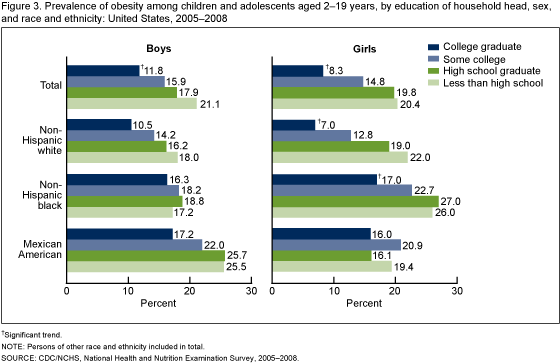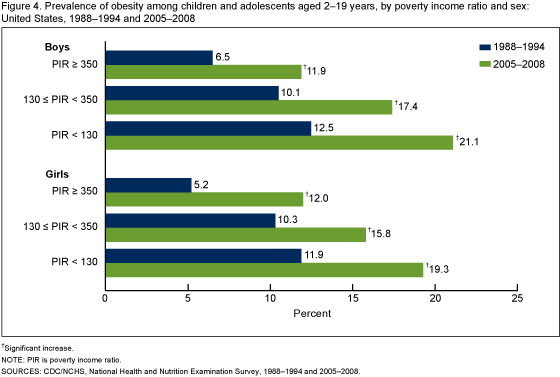Obesity and Socioeconomic Status in Children and Adolescents: United States, 2005-2008
On This Page
- Key findings
- Among both boys and girls obesity prevalence decreases as income increases, but this relation is not consistent across race and ethnicity groups.
- Most obese children and adolescents are not low income (below 130% of the poverty level).
- Childhood obesity prevalence decreases as the education of the head of household increases, but the relationship is not consistent across race and ethnicity groups.
- Between 1988-1994 and 2007-2008 the prevalence of childhood obesity increased at all income levels.
- Between 1988-1994 and 2005-2008 childhood obesity prevalence increased in households headed by individuals with all levels of education.
- Summary
- Definitions
- Data source and methods
- About the authors
- References
- Suggested citation
NCHS Data Brief No. 51, December 2010
PDF Version (1.2 MB)
Cynthia L. Ogden, Ph.D.; Molly M. Lamb, Ph.D.; Margaret D. Carroll, M.S.P.H.; and Katherine M. Flegal, Ph.D.
Key findings
Data from the National Health and Nutrition Examination Survey, 2005-2008
- Low income children and adolescents are more likely to be obese than their higher income counterparts, but the relationship is not consistent across race and ethnicity groups.
- Most obese children and adolescents are not low income (below 130% of the poverty level).
- Children and adolescents living in households where the head of household has a college degree are less likely to be obese compared with those living in households where the household head has less education, but the relationship is not consistent across race and ethnicity groups.
- Between 1988-1994 and 2007-2008 the prevalence of childhood obesity increased at all income and education levels.
In 2007-2008 almost 17% of children and adolescents aged 2-19 years were obese (1). Childhood obesity often tracks to adulthood (2) and, in the short run, childhood obesity can lead to psychosocial problems and cardiovascular risk factors such as high blood pressure, high cholesterol, and abnormal glucose tolerance or diabetes (3). Studies have suggested that obesity is greater in the low income population than in higher income individuals (4). This data brief presents the most recent national data on childhood obesity and its association with poverty income ratio (PIR) and education of household head. Results are presented by sex and race and ethnicity.
Keywords: obesity, children, income, education
Among both boys and girls obesity prevalence decreases as income increases, but this relation is not consistent across race and ethnicity groups.
The prevalence of obesity among boys living in households with income at or above 350% of the poverty level is 11.9%, while 21.1% of those who live below 130% of the poverty level are obese. Among girls, 12.0% of those with income at or above 350% of the poverty level are obese while 19.3% of those with income below 130% of the poverty level are obese.
The relationship between income and obesity prevalence is significant among non-Hispanic white boys; 10.2% of those living in households with income at or above 350% of the poverty level are obese compared with 20.7% of those in households below 130% of the poverty level. Among non-Hispanic white girls, 10.6% of those living at or above 350% of the poverty level are obese, and 18.3% of those living below 130% of the poverty level are obese. Among non-Hispanic black and Mexican-American children and adolescents, there is no significant trend in prevalence by income level for either boys or girls. In fact, the relationship does not appear to be consistent; among Mexican-American girls, although the difference is not significant, 21.0% of those living at or above 350% of the poverty level are obese compared with 16.2% of those living below 130% of the poverty level (Figure 1).
Most obese children and adolescents are not low income (below 130% of the poverty level).
Of the approximately 12 million children and adolescents who are obese, 24% (almost 3 million) live in households with income at or above 350% of the poverty level, 38% (approximately 4.5 million) have incomes between 130% and 350% of the poverty level, and 38% (approximately 4.5 million) live below 130% of the poverty level. Of the approximately 6 million obese non-Hispanic white children and adolescents, the majority (4.4 million) live in households with income at or above 130% of the poverty level (Figure 2).
Childhood obesity prevalence decreases as the education of the head of household increases, but the relationship is not consistent across race and ethnicity groups.
Overall, there is a significant inverse relationship between obesity prevalence and education of household head. Among boys, 11.8% of those living in households where the household head has at least a college degree are obese compared with 21.1% of those living in households where the head of the household has less than a high school degree. Among girls, 8.3% of children and adolescents in households where the household head has at least a college degree are obese compared with 20.4% in households headed by individuals with less than a high school degree.
Among non-Hispanic white and black girls, the prevalence of obesity is significantly lower in households headed by individuals with a college degree than in households headed by individuals with less than a high school degree (Figure 3).
Between 1988-1994 and 2007-2008 the prevalence of childhood obesity increased at all income levels.
Among boys living at or above 350% of the poverty level, the prevalence of obesity increased from 6.5% to 11.9% between 1988-1994 and 2005-2008. Similar increases were seen among those with income between 130% and 350% of the poverty level and among those with income below 130% of the poverty level.
Among girls, the prevalence of obesity increased from 5.2% to 12.0% among those living at or above 350% of the poverty level, from 10.3% to 15.8% among those between 130% and 350% of the poverty level, and from 11.9% to 19.3% among those below 130% of the poverty level between 1988-1994 and 2005-2008 (Figure 4).
Between 1988-1994 and 2005-2008 childhood obesity prevalence increased in households headed by individuals with all levels of education.
In boys, the prevalence of childhood obesity increased significantly between 1988-1994 and 2005-2008 in households at all education levels. Among boys living in households headed by those with a college degree the prevalence increased from 4.5% to 11.8%, while in households headed by individuals with less than a high school degree, the prevalence of obesity increased from 15.3% to 21.1% between 1988-1994 and 2005-2008.
Among girls, the prevalence of obesity increased significantly in households at all levels of education except where the head of the household had a college degree. Among girls in households with less than a high school degree, the prevalence increased from 11.4% to 20.4% (Figure 5).
Summary
Among non-Hispanic white children and adolescents, the prevalence of obesity increases as income decreases, yet the majority of non-Hispanic white children and adolescents who are obese do not live below 130% of the poverty level. In fact, overall, the majority of obese children do not live below 130% of the poverty level. All boys and girls and non-Hispanic white and non-Hispanic black girls in highly educated households are less likely to be obese compared with their counterparts in households where the head has less than a high school degree. Between 1988-1994 and 2005-2008 the prevalence of obesity increased in children at all levels of income and education except among girls in households where the head had at least a college degree.
Definitions
Obesity: Body mass index (BMI) ≥ age- and sex-specific 95th percentile of the 2000 CDC growth charts (5). BMI is calculated as weight in kilograms divided by height in meters squared, rounded to one decimal place.
Poverty income ratio (PIR): The ratio of household income to the poverty threshold after accounting for inflation and family size. In 2008, a PIR of 350% was equivalent to approximately $77,000 for a family of four; a PIR of 130% was equivalent to approximately $29,000 for a family of four. In 2008, median household income was approximately $50,000 and 19% of children younger than 18 lived below the poverty level . The cut point for participation in the Supplemental Nutrition Assistance Program (SNAP) is 130% of the poverty level.
Data source and methods
The National Health and Nutrition Examination Survey (NHANES) data were used for these analyses. NHANES is a cross-sectional survey designed to monitor the health and nutritional status of the civilian, noninstitutionalized U.S. population (6). The survey consists of interviews conducted in participants’ homes, standardized physical examinations conducted in mobile examination centers, and laboratory tests utilizing blood and urine specimens provided by participants during the physical examination.
The NHANES sample is selected through a complex, multistage design that includes selection of primary sampling units (counties), household segments within the counties, and finally sample persons from selected households. The sample design includes oversampling to obtain reliable estimates of health and nutritional measures for population subgroups. In 1988-1994 and 2005-2008, African-American and Mexican-American children and adolescents were oversampled. In 1999, NHANES became a continuous survey, fielded on an ongoing basis. Each year of data collection is based on a representative sample covering all ages of the civilian, noninstitutionalized population. Public-use data files are released in 2-year cycles.
Sample weights, which account for the differential probabilities of selection, nonresponse, and noncoverage, were incorporated into the estimation process. The standard errors of the percentages were estimated using Taylor Series Linearization, a method that incorporates the sample weights and sample design.
Estimates of the number of obese individuals were calculated using the average Current Population Survey (CPS) totals for 2005-2006 and 2007-2008. Differences in prevalence between groups were evaluated using a univariate t-statistic at the p< 0.05 significance level. Tests of trends were done using the p<0.05 significance level. All differences reported are statistically significant unless otherwise indicated. Statistical analyses were conducted using the SAS System for Windows (release 9.1; SAS Institute Inc, Cary, N.C.) and SUDAAN (release 9.0; Research Triangle Institute, Research Triangle Park, N.C.).
About the authors
Cynthia L. Ogden, Molly M. Lamb, and Margaret D. Carroll are with the Centers for Disease Control and Prevention’s National Center for Health Statistics (NCHS), Division of Health and Nutrition Examination Surveys. Katherine M. Flegal is with NCHS’ Office of the Director.
References
- Ogden CL, Carroll MD, Curtin LR, Lamb MM, Flegal KM. Prevalence of high body mass index in U.S. children and adolescents, 2007-2008. JAMA 303:242-9. 2010.
- Singh AS, Mulder C, Twisk JW, Van MW, Chinapaw MJ. Tracking of childhood overweight into adulthood: A systematic review of the literature. Obes Rev 9:474-88. 2008.
- Freedman DS, Mei Z, Srinivasan SR, Berenson GS, Dietz WH. Cardiovascular risk factors and excess adiposity among overweight children and adolescents: The Bogalusa Heart Study. J Pediatr 150:12-7. 2007.
- Wang Y, Zhang Q. Are American children and adolescents of low socioeconomic status at increased risk of obesity? Changes in the association between overweight and family income between 1971 and 2002. Am J Clin Nutr 84:707-16. 2006.
- Kuczmarski RJ, Ogden CL, Guo SS, et al. 2000 CDC growth charts for the United States: Methods and development. National Center for Health Statistics. Vital Health Stat 11(246). 2002.
- Centers for Disease Control and Prevention. National Center for Health Statistics. National Health and Nutrition Examination Survey. Accessed November 18, 2010.
Suggested citation
Ogden CL, Lamb MM, Carroll MD, Flegal, KM. Obesity and socioeconomic status in children: United States 1988-1994 and 2005-2008. NCHS data brief no 51. Hyattsville, MD: National Center for Health Statistics. 2010.
Copyright information
All material appearing in this report is in the public domain and may be reproduced or copied without permission; citation as to source, however, is appreciated.
National Center for Health Statistics
Edward J. Sondik, Ph.D., Director
Jennifer H. Madans, Ph.D., Associate Director for Science
Division of Health and Nutrition Examination Surveys
Clifford L. Johnson, M.S.P.H., Director
- Page last reviewed: November 6, 2015
- Page last updated: December 14, 2010
- Content source:


 ShareCompartir
ShareCompartir




